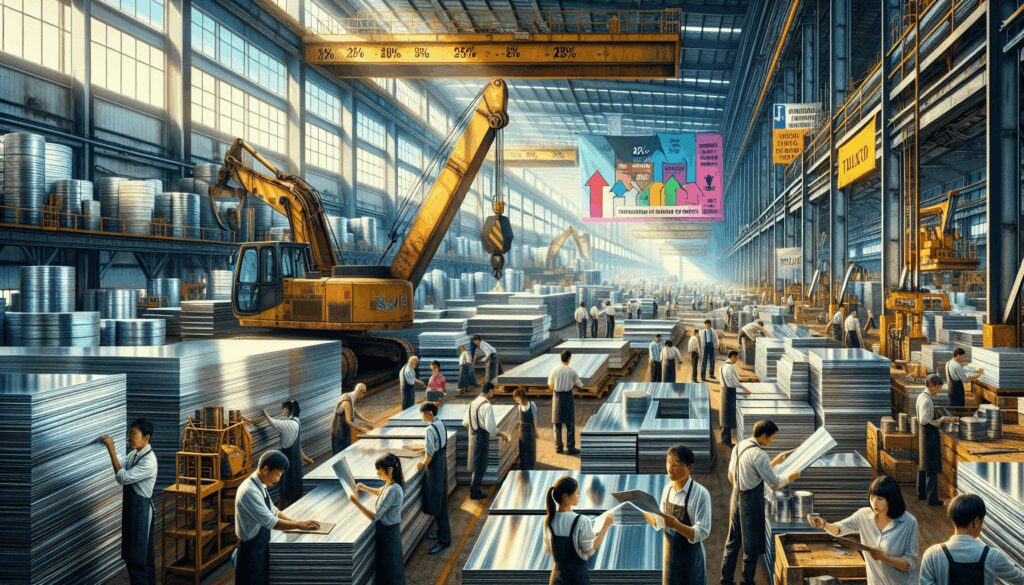Final list of steel and aluminum products from China that will be subject to a 25 per cent surtax

The recent implementation of the Canada Surtax Order (2024) has stirred significant discussions regarding the import of steel and aluminum products from China. The aim of this order is to protect Canadian industries and workers from unfair trade practices. Below, we will explore various aspects of the surtax and its implications for businesses and trade.
This article will provide a comprehensive overview of the final list of steel and aluminum products from China that will be subject to a 25 per cent surtax, along with essential information about compliance, exemptions, and the impact on Canadian trade.
- What is the China surtax order (2024)?
- How does the 25% surtax affect steel and aluminum imports?
- What are the exceptions to the surtax on Chinese goods?
- What proof of origin is required for importing these products?
- How can importers comply with the CBSA assessment system?
- What are the consequences for non-compliance with the surtax regulations?
- What is the regulatory impact of the China surtax order on Canadian trade?
- FAQ
What is the China surtax order (2024)?
The China surtax order, effective from October 22, 2024, imposes a 25% surtax on selected steel and aluminum products imported from China. The primary objective is to safeguard Canadian manufacturing from the influx of inexpensive imports that disrupt market equilibrium.
This order categorizes various steel products based on factors such as carbon content and product form, assigning specific tariff codes under the Harmonized System (HS). This categorization helps ensure that the correct tariffs are applied to each product.
Under this order, the Canada Border Services Agency (CBSA) is responsible for overseeing compliance and enforcement. Importers must navigate these regulations to avoid penalties and ensure they are adhering to the required standards.
How does the 25% surtax affect steel and aluminum imports?
The implementation of a 25% surtax on steel and aluminum imports significantly increases the cost of these products for importers. This additional cost can lead to higher prices for consumers and may affect the overall demand for imported materials.
Furthermore, businesses relying on imported steel and aluminum may need to reassess their supply chains. Companies might consider sourcing materials from different countries or investing in domestic production to mitigate the impact of the surtax.
 Provincial Health Insurance: What’s Covered, What’s Not, and Why You Need a Backup
Provincial Health Insurance: What’s Covered, What’s Not, and Why You Need a BackupMoreover, the surtax aims to level the playing field for Canadian manufacturers, allowing them to compete more effectively against foreign producers who benefit from lower labor costs and less stringent regulations.
What are the exceptions to the surtax on Chinese goods?
Not all steel and aluminum products from China are subject to the surtax. Certain exemptions exist, particularly for goods that are in transit or fall under specific categories outlined by the CBSA. Understanding these exceptions can be crucial for importers.
- Goods in transit prior to the effective date of the surtax.
- Products that meet specific criteria outlined in the Harmonized System.
- Items intended for use in manufacturing processes that cannot be sourced domestically.
Importers must provide adequate documentation to prove eligibility for these exemptions. This often includes documentation showing proof of origin and compliance with Canadian regulations.
What proof of origin is required for importing these products?
To comply with the regulations under the surtax order, importers must furnish proof of origin for the steel and aluminum products they intend to bring into Canada. This documentation is essential to ensure that the products qualify for the appropriate tariff treatment.
Proof of origin may include certificates of origin, invoices from suppliers, and any relevant shipping documentation. The CBSA has strict guidelines regarding what constitutes acceptable proof, making it crucial for importers to be well-informed about these requirements.
Failure to provide the necessary documentation could result in penalties, including the imposition of the surtax even on products that may qualify for exemptions. Hence, meticulous record-keeping and adherence to regulatory standards are imperative for compliance.
How can importers comply with the CBSA assessment system?
Compliance with the CBSA assessment system is essential for importers of steel and aluminum products from China. To navigate this system effectively, importers should familiarize themselves with the guidelines set forth by the CBSA.
 How to open a holding company in Canada?
How to open a holding company in Canada?Importers need to ensure that they are correctly classifying their products under the appropriate Harmonized System codes. This classification directly influences the duties and tariffs applied to the imports.
Additionally, staying updated on any changes to the surtax order and the CBSA regulations is critical. Regular training and consultation with logistics and compliance specialists can aid businesses in maintaining adherence to the ever-evolving regulatory landscape.
What are the consequences for non-compliance with the surtax regulations?
The consequences of non-compliance with the surtax regulations can be significant for importers. Penalties may include hefty fines, additional tariffs, and delays in customs clearance, which can disrupt supply chains.
In some cases, repeated violations can lead to more severe repercussions, such as increased scrutiny from the CBSA or even legal action. As such, it is vital for importers to understand and comply with all aspects of the surtax order to avoid these pitfalls.
Moreover, non-compliance can damage relationships with suppliers and customers, as businesses may struggle to meet demand if their imports are delayed or penalized.
What is the regulatory impact of the China surtax order on Canadian trade?
The regulatory impact of the China surtax order on Canadian trade is profound. By imposing a surtax on specific steel and aluminum products, Canada aims to protect its domestic industries from unfair competition.
This measure could lead to a shift in trade patterns, as importers may seek alternative sources for their materials. There may also be a renewed focus on domestic production, ultimately benefiting the local economy.
 How do I become a wedding officiant in Ontario?
How do I become a wedding officiant in Ontario?Additionally, the surtax could prompt negotiations between Canada and China to address trade imbalances and ensure fair practices moving forward. The long-term effects on trade relationships will depend on how both countries navigate these new regulations.
FAQ
What is the surtax on Chinese steel goods?
The surtax on Chinese steel goods is a 25% surcharge imposed on specific steel and aluminum products imported from China. This measure aims to protect Canadian manufacturers from unfair competition by increasing the cost of these imports.
What are the new tariffs on Chinese steel in Canada?
The new tariffs on Chinese steel in Canada consist of a 25% surtax that applies to a select list of products. The tariffs are part of the Canada Surtax Order (2024), which categorizes products based on their HS codes.
What is the 25 tariff in Canada?
The 25 tariff refers to the surcharge imposed on certain steel and aluminum imports from China. It is part of an effort to protect Canadian industries from unfair trade practices and is applicable only to specific products outlined in the surtax order.
What is the import tax on steel from China?
The import tax on steel from China, under the current regulations, is effectively a 25% surtax applied to various steel products. Importers must comply with the CBSA’s requirements to avoid additional penalties.

Related content